Facilitating Change in Health and Social Care Services: A Report
VerifiedAdded on 2023/02/02
|12
|3823
|87
Report
AI Summary
This report delves into the process of facilitating change within health and social care services, using Liverpool Home Care as a primary case study. The introduction sets the stage by highlighting the need for change and its impact on service delivery. Task 1 identifies key drivers and challenges associated with change. Task 2 outlines strategies for measuring and evaluating the impact of recent changes, including the use of CQC inspections, quality assurance, self-evaluation, and feedback. It also explores methods like surveys, interviews, and fishbone analysis to measure impact, along with proposing appropriate service responses. Task 3 focuses on change management principles, particularly Kotter's principles, and assesses how changes are planned and monitored. The report emphasizes the importance of effective leadership, patient participation, and the ethical considerations within health and social care environments, culminating in a comprehensive understanding of change implementation and its effects.
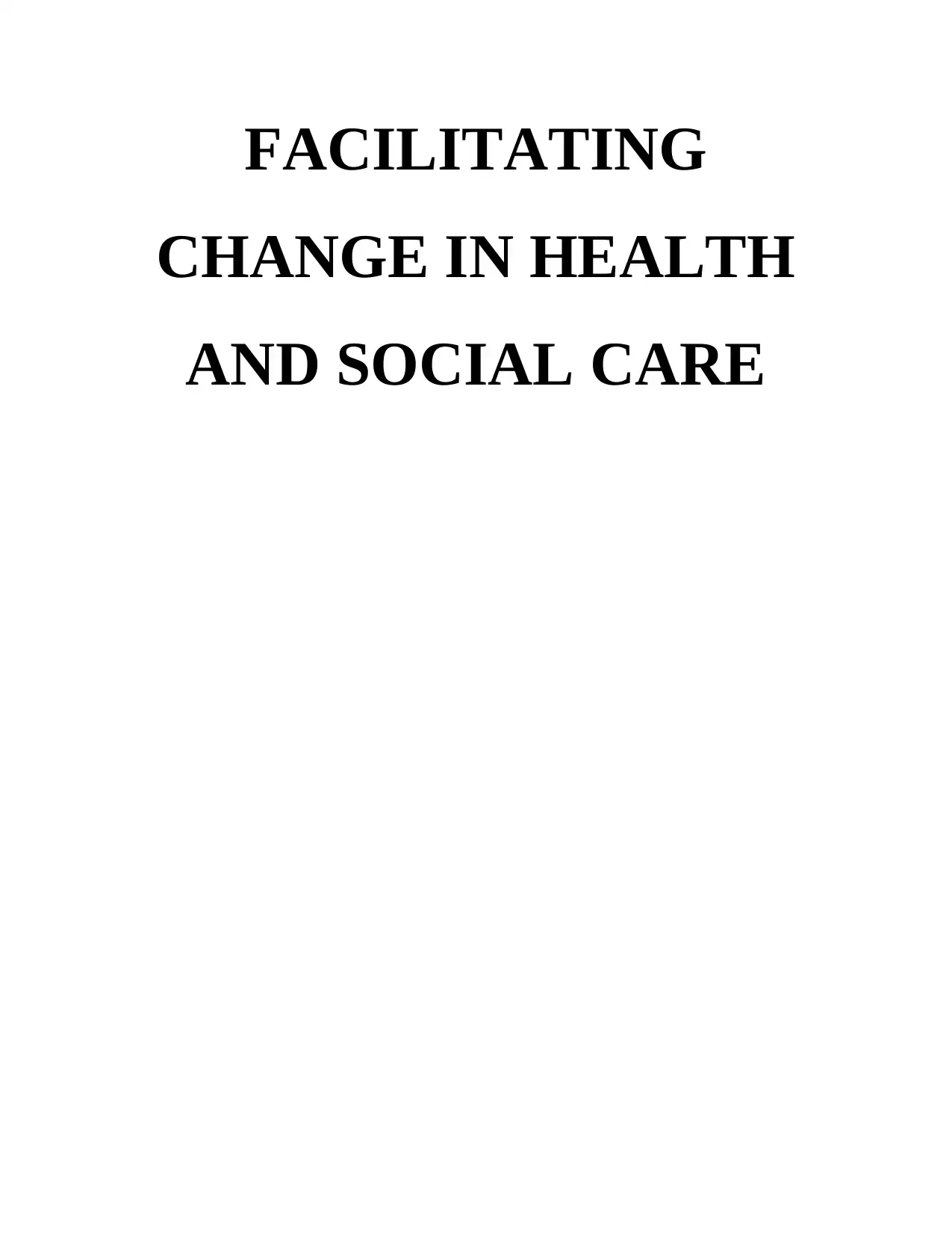
FACILITATING
CHANGE IN HEALTH
AND SOCIAL CARE
CHANGE IN HEALTH
AND SOCIAL CARE
Paraphrase This Document
Need a fresh take? Get an instant paraphrase of this document with our AI Paraphraser
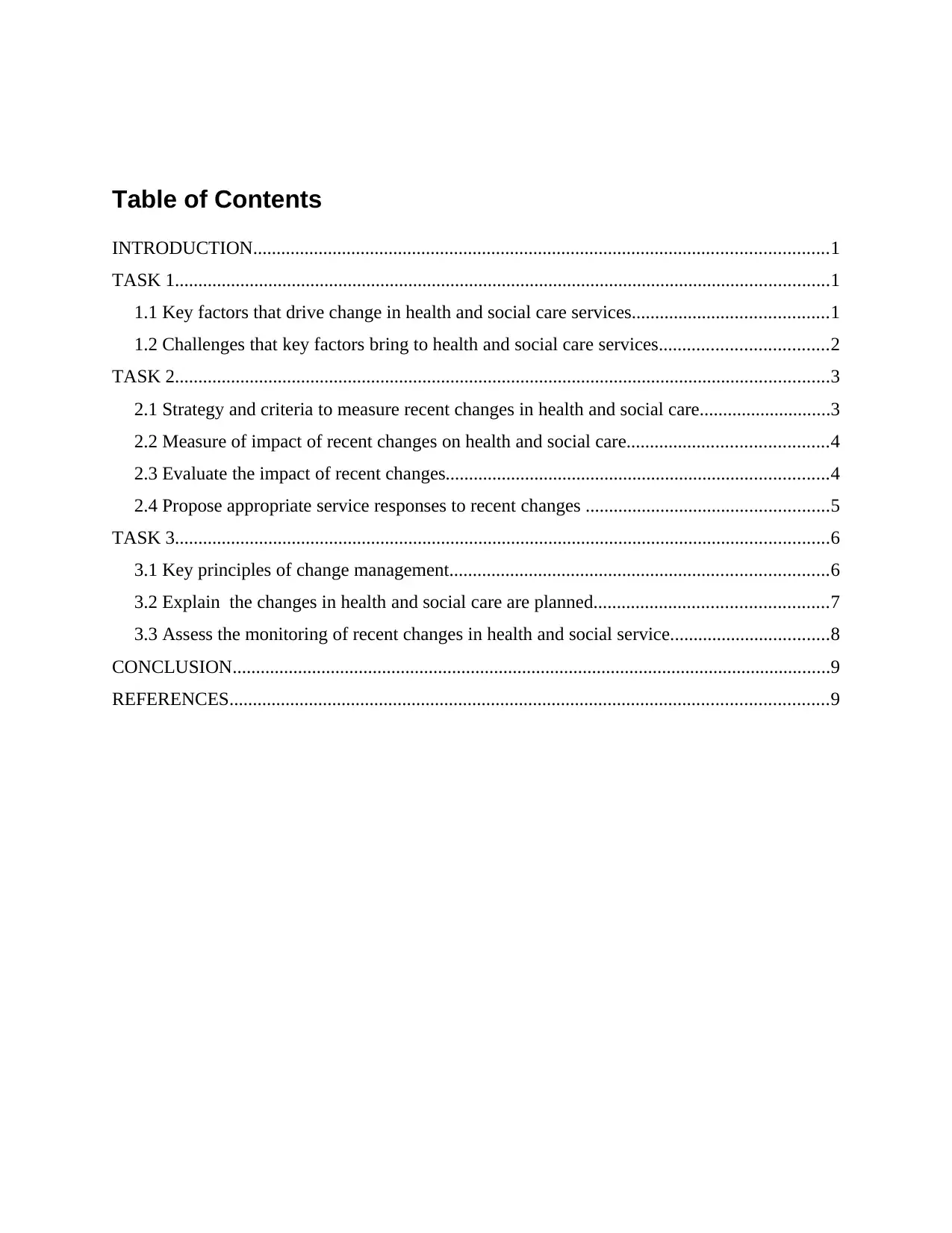
Table of Contents
INTRODUCTION...........................................................................................................................1
TASK 1............................................................................................................................................1
1.1 Key factors that drive change in health and social care services..........................................1
1.2 Challenges that key factors bring to health and social care services....................................2
TASK 2............................................................................................................................................3
2.1 Strategy and criteria to measure recent changes in health and social care............................3
2.2 Measure of impact of recent changes on health and social care...........................................4
2.3 Evaluate the impact of recent changes..................................................................................4
2.4 Propose appropriate service responses to recent changes ....................................................5
TASK 3............................................................................................................................................6
3.1 Key principles of change management.................................................................................6
3.2 Explain the changes in health and social care are planned..................................................7
3.3 Assess the monitoring of recent changes in health and social service..................................8
CONCLUSION................................................................................................................................9
REFERENCES................................................................................................................................9
INTRODUCTION...........................................................................................................................1
TASK 1............................................................................................................................................1
1.1 Key factors that drive change in health and social care services..........................................1
1.2 Challenges that key factors bring to health and social care services....................................2
TASK 2............................................................................................................................................3
2.1 Strategy and criteria to measure recent changes in health and social care............................3
2.2 Measure of impact of recent changes on health and social care...........................................4
2.3 Evaluate the impact of recent changes..................................................................................4
2.4 Propose appropriate service responses to recent changes ....................................................5
TASK 3............................................................................................................................................6
3.1 Key principles of change management.................................................................................6
3.2 Explain the changes in health and social care are planned..................................................7
3.3 Assess the monitoring of recent changes in health and social service..................................8
CONCLUSION................................................................................................................................9
REFERENCES................................................................................................................................9
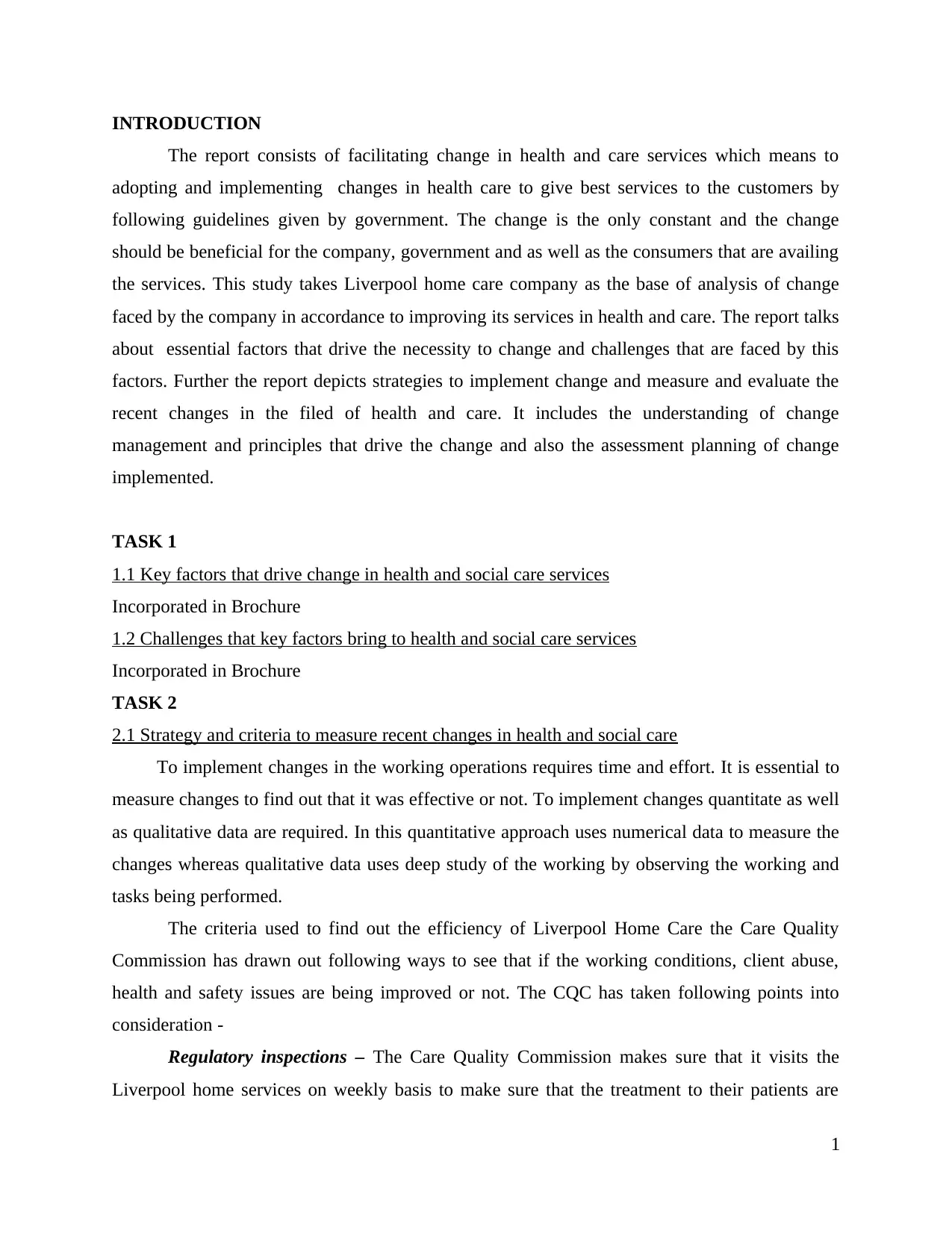
INTRODUCTION
The report consists of facilitating change in health and care services which means to
adopting and implementing changes in health care to give best services to the customers by
following guidelines given by government. The change is the only constant and the change
should be beneficial for the company, government and as well as the consumers that are availing
the services. This study takes Liverpool home care company as the base of analysis of change
faced by the company in accordance to improving its services in health and care. The report talks
about essential factors that drive the necessity to change and challenges that are faced by this
factors. Further the report depicts strategies to implement change and measure and evaluate the
recent changes in the filed of health and care. It includes the understanding of change
management and principles that drive the change and also the assessment planning of change
implemented.
TASK 1
1.1 Key factors that drive change in health and social care services
Incorporated in Brochure
1.2 Challenges that key factors bring to health and social care services
Incorporated in Brochure
TASK 2
2.1 Strategy and criteria to measure recent changes in health and social care
To implement changes in the working operations requires time and effort. It is essential to
measure changes to find out that it was effective or not. To implement changes quantitate as well
as qualitative data are required. In this quantitative approach uses numerical data to measure the
changes whereas qualitative data uses deep study of the working by observing the working and
tasks being performed.
The criteria used to find out the efficiency of Liverpool Home Care the Care Quality
Commission has drawn out following ways to see that if the working conditions, client abuse,
health and safety issues are being improved or not. The CQC has taken following points into
consideration -
Regulatory inspections – The Care Quality Commission makes sure that it visits the
Liverpool home services on weekly basis to make sure that the treatment to their patients are
1
The report consists of facilitating change in health and care services which means to
adopting and implementing changes in health care to give best services to the customers by
following guidelines given by government. The change is the only constant and the change
should be beneficial for the company, government and as well as the consumers that are availing
the services. This study takes Liverpool home care company as the base of analysis of change
faced by the company in accordance to improving its services in health and care. The report talks
about essential factors that drive the necessity to change and challenges that are faced by this
factors. Further the report depicts strategies to implement change and measure and evaluate the
recent changes in the filed of health and care. It includes the understanding of change
management and principles that drive the change and also the assessment planning of change
implemented.
TASK 1
1.1 Key factors that drive change in health and social care services
Incorporated in Brochure
1.2 Challenges that key factors bring to health and social care services
Incorporated in Brochure
TASK 2
2.1 Strategy and criteria to measure recent changes in health and social care
To implement changes in the working operations requires time and effort. It is essential to
measure changes to find out that it was effective or not. To implement changes quantitate as well
as qualitative data are required. In this quantitative approach uses numerical data to measure the
changes whereas qualitative data uses deep study of the working by observing the working and
tasks being performed.
The criteria used to find out the efficiency of Liverpool Home Care the Care Quality
Commission has drawn out following ways to see that if the working conditions, client abuse,
health and safety issues are being improved or not. The CQC has taken following points into
consideration -
Regulatory inspections – The Care Quality Commission makes sure that it visits the
Liverpool home services on weekly basis to make sure that the treatment to their patients are
1
⊘ This is a preview!⊘
Do you want full access?
Subscribe today to unlock all pages.

Trusted by 1+ million students worldwide
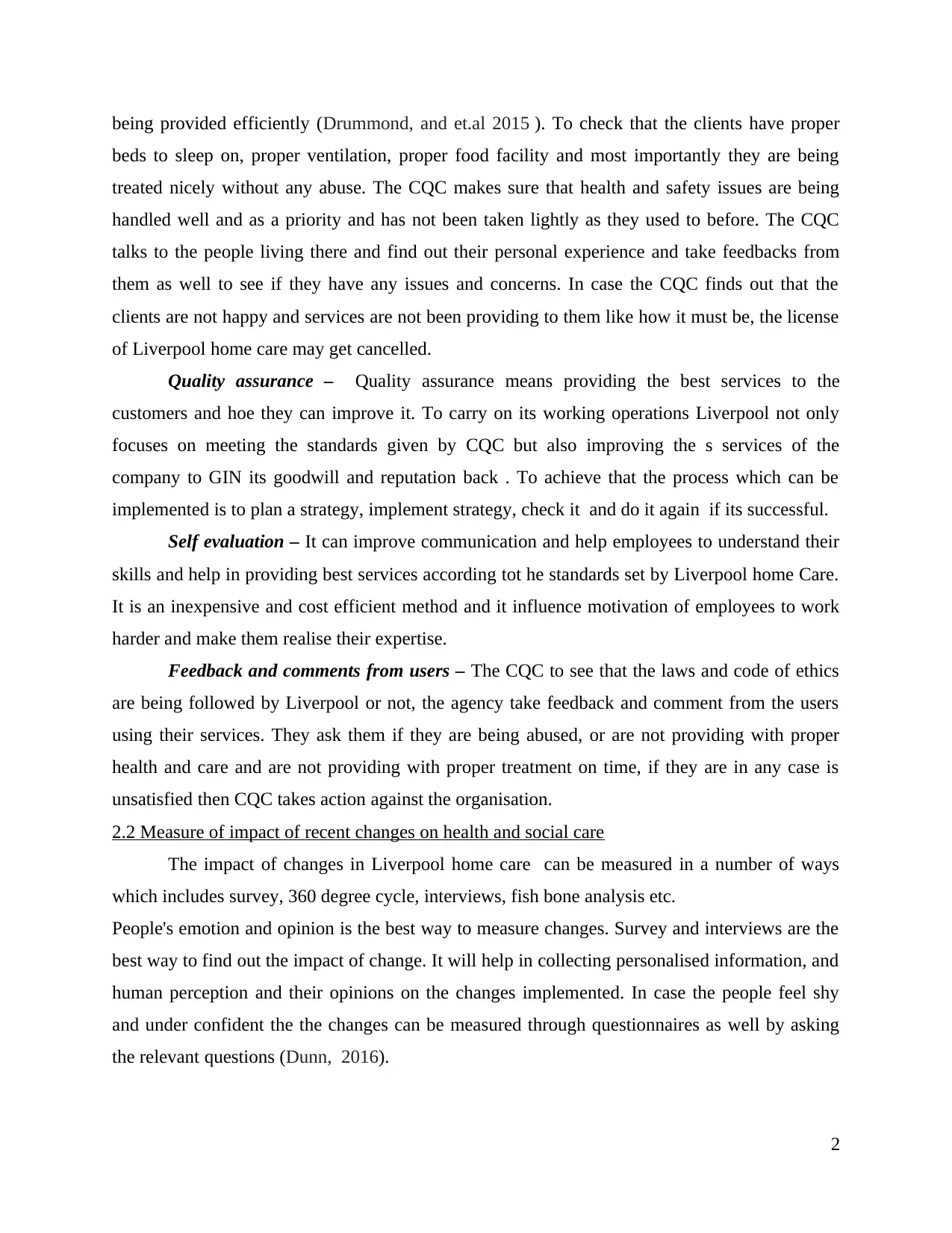
being provided efficiently (Drummond, and et.al 2015 ). To check that the clients have proper
beds to sleep on, proper ventilation, proper food facility and most importantly they are being
treated nicely without any abuse. The CQC makes sure that health and safety issues are being
handled well and as a priority and has not been taken lightly as they used to before. The CQC
talks to the people living there and find out their personal experience and take feedbacks from
them as well to see if they have any issues and concerns. In case the CQC finds out that the
clients are not happy and services are not been providing to them like how it must be, the license
of Liverpool home care may get cancelled.
Quality assurance – Quality assurance means providing the best services to the
customers and hoe they can improve it. To carry on its working operations Liverpool not only
focuses on meeting the standards given by CQC but also improving the s services of the
company to GIN its goodwill and reputation back . To achieve that the process which can be
implemented is to plan a strategy, implement strategy, check it and do it again if its successful.
Self evaluation – It can improve communication and help employees to understand their
skills and help in providing best services according tot he standards set by Liverpool home Care.
It is an inexpensive and cost efficient method and it influence motivation of employees to work
harder and make them realise their expertise.
Feedback and comments from users – The CQC to see that the laws and code of ethics
are being followed by Liverpool or not, the agency take feedback and comment from the users
using their services. They ask them if they are being abused, or are not providing with proper
health and care and are not providing with proper treatment on time, if they are in any case is
unsatisfied then CQC takes action against the organisation.
2.2 Measure of impact of recent changes on health and social care
The impact of changes in Liverpool home care can be measured in a number of ways
which includes survey, 360 degree cycle, interviews, fish bone analysis etc.
People's emotion and opinion is the best way to measure changes. Survey and interviews are the
best way to find out the impact of change. It will help in collecting personalised information, and
human perception and their opinions on the changes implemented. In case the people feel shy
and under confident the the changes can be measured through questionnaires as well by asking
the relevant questions (Dunn, 2016).
2
beds to sleep on, proper ventilation, proper food facility and most importantly they are being
treated nicely without any abuse. The CQC makes sure that health and safety issues are being
handled well and as a priority and has not been taken lightly as they used to before. The CQC
talks to the people living there and find out their personal experience and take feedbacks from
them as well to see if they have any issues and concerns. In case the CQC finds out that the
clients are not happy and services are not been providing to them like how it must be, the license
of Liverpool home care may get cancelled.
Quality assurance – Quality assurance means providing the best services to the
customers and hoe they can improve it. To carry on its working operations Liverpool not only
focuses on meeting the standards given by CQC but also improving the s services of the
company to GIN its goodwill and reputation back . To achieve that the process which can be
implemented is to plan a strategy, implement strategy, check it and do it again if its successful.
Self evaluation – It can improve communication and help employees to understand their
skills and help in providing best services according tot he standards set by Liverpool home Care.
It is an inexpensive and cost efficient method and it influence motivation of employees to work
harder and make them realise their expertise.
Feedback and comments from users – The CQC to see that the laws and code of ethics
are being followed by Liverpool or not, the agency take feedback and comment from the users
using their services. They ask them if they are being abused, or are not providing with proper
health and care and are not providing with proper treatment on time, if they are in any case is
unsatisfied then CQC takes action against the organisation.
2.2 Measure of impact of recent changes on health and social care
The impact of changes in Liverpool home care can be measured in a number of ways
which includes survey, 360 degree cycle, interviews, fish bone analysis etc.
People's emotion and opinion is the best way to measure changes. Survey and interviews are the
best way to find out the impact of change. It will help in collecting personalised information, and
human perception and their opinions on the changes implemented. In case the people feel shy
and under confident the the changes can be measured through questionnaires as well by asking
the relevant questions (Dunn, 2016).
2
Paraphrase This Document
Need a fresh take? Get an instant paraphrase of this document with our AI Paraphraser
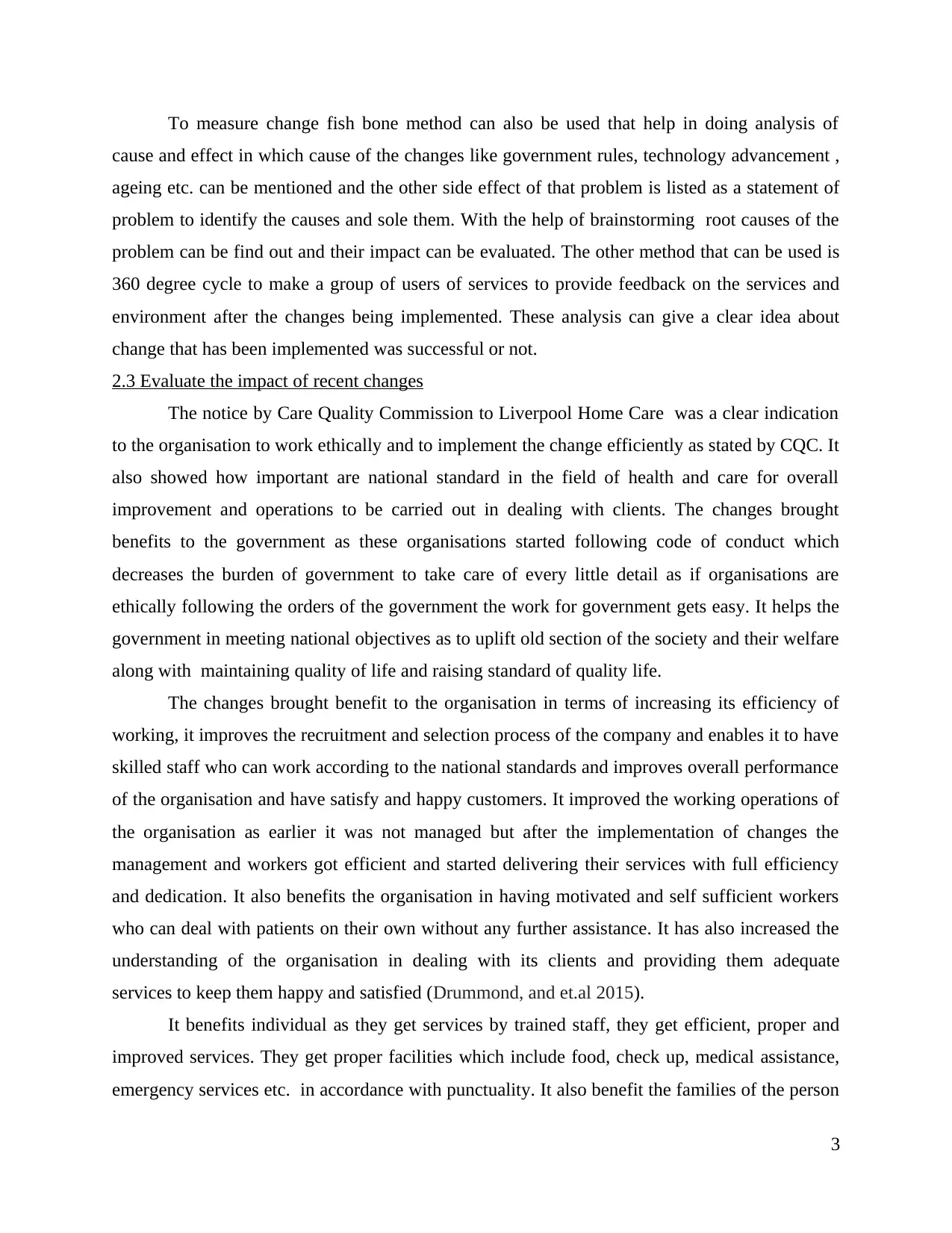
To measure change fish bone method can also be used that help in doing analysis of
cause and effect in which cause of the changes like government rules, technology advancement ,
ageing etc. can be mentioned and the other side effect of that problem is listed as a statement of
problem to identify the causes and sole them. With the help of brainstorming root causes of the
problem can be find out and their impact can be evaluated. The other method that can be used is
360 degree cycle to make a group of users of services to provide feedback on the services and
environment after the changes being implemented. These analysis can give a clear idea about
change that has been implemented was successful or not.
2.3 Evaluate the impact of recent changes
The notice by Care Quality Commission to Liverpool Home Care was a clear indication
to the organisation to work ethically and to implement the change efficiently as stated by CQC. It
also showed how important are national standard in the field of health and care for overall
improvement and operations to be carried out in dealing with clients. The changes brought
benefits to the government as these organisations started following code of conduct which
decreases the burden of government to take care of every little detail as if organisations are
ethically following the orders of the government the work for government gets easy. It helps the
government in meeting national objectives as to uplift old section of the society and their welfare
along with maintaining quality of life and raising standard of quality life.
The changes brought benefit to the organisation in terms of increasing its efficiency of
working, it improves the recruitment and selection process of the company and enables it to have
skilled staff who can work according to the national standards and improves overall performance
of the organisation and have satisfy and happy customers. It improved the working operations of
the organisation as earlier it was not managed but after the implementation of changes the
management and workers got efficient and started delivering their services with full efficiency
and dedication. It also benefits the organisation in having motivated and self sufficient workers
who can deal with patients on their own without any further assistance. It has also increased the
understanding of the organisation in dealing with its clients and providing them adequate
services to keep them happy and satisfied (Drummond, and et.al 2015).
It benefits individual as they get services by trained staff, they get efficient, proper and
improved services. They get proper facilities which include food, check up, medical assistance,
emergency services etc. in accordance with punctuality. It also benefit the families of the person
3
cause and effect in which cause of the changes like government rules, technology advancement ,
ageing etc. can be mentioned and the other side effect of that problem is listed as a statement of
problem to identify the causes and sole them. With the help of brainstorming root causes of the
problem can be find out and their impact can be evaluated. The other method that can be used is
360 degree cycle to make a group of users of services to provide feedback on the services and
environment after the changes being implemented. These analysis can give a clear idea about
change that has been implemented was successful or not.
2.3 Evaluate the impact of recent changes
The notice by Care Quality Commission to Liverpool Home Care was a clear indication
to the organisation to work ethically and to implement the change efficiently as stated by CQC. It
also showed how important are national standard in the field of health and care for overall
improvement and operations to be carried out in dealing with clients. The changes brought
benefits to the government as these organisations started following code of conduct which
decreases the burden of government to take care of every little detail as if organisations are
ethically following the orders of the government the work for government gets easy. It helps the
government in meeting national objectives as to uplift old section of the society and their welfare
along with maintaining quality of life and raising standard of quality life.
The changes brought benefit to the organisation in terms of increasing its efficiency of
working, it improves the recruitment and selection process of the company and enables it to have
skilled staff who can work according to the national standards and improves overall performance
of the organisation and have satisfy and happy customers. It improved the working operations of
the organisation as earlier it was not managed but after the implementation of changes the
management and workers got efficient and started delivering their services with full efficiency
and dedication. It also benefits the organisation in having motivated and self sufficient workers
who can deal with patients on their own without any further assistance. It has also increased the
understanding of the organisation in dealing with its clients and providing them adequate
services to keep them happy and satisfied (Drummond, and et.al 2015).
It benefits individual as they get services by trained staff, they get efficient, proper and
improved services. They get proper facilities which include food, check up, medical assistance,
emergency services etc. in accordance with punctuality. It also benefit the families of the person
3
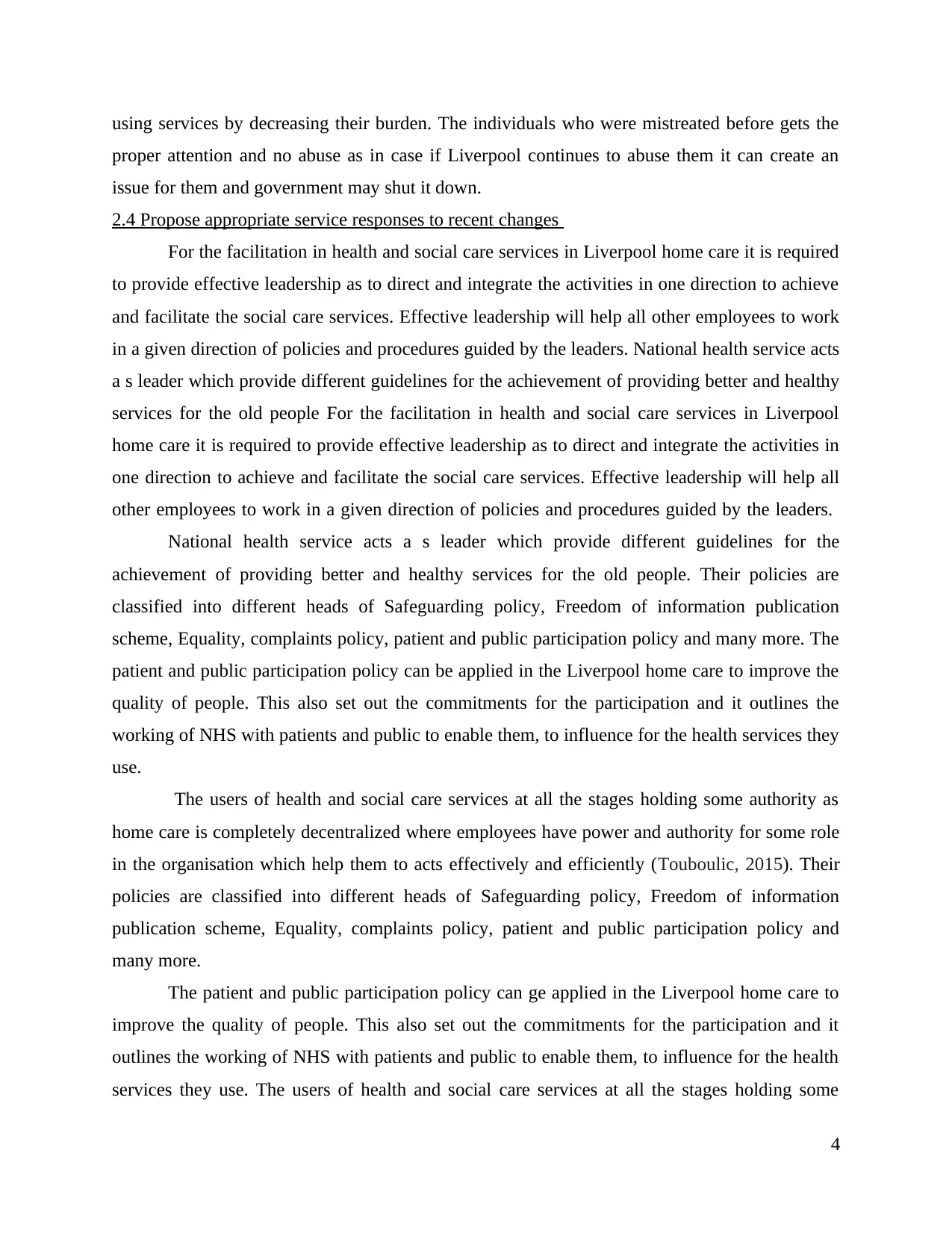
using services by decreasing their burden. The individuals who were mistreated before gets the
proper attention and no abuse as in case if Liverpool continues to abuse them it can create an
issue for them and government may shut it down.
2.4 Propose appropriate service responses to recent changes
For the facilitation in health and social care services in Liverpool home care it is required
to provide effective leadership as to direct and integrate the activities in one direction to achieve
and facilitate the social care services. Effective leadership will help all other employees to work
in a given direction of policies and procedures guided by the leaders. National health service acts
a s leader which provide different guidelines for the achievement of providing better and healthy
services for the old people For the facilitation in health and social care services in Liverpool
home care it is required to provide effective leadership as to direct and integrate the activities in
one direction to achieve and facilitate the social care services. Effective leadership will help all
other employees to work in a given direction of policies and procedures guided by the leaders.
National health service acts a s leader which provide different guidelines for the
achievement of providing better and healthy services for the old people. Their policies are
classified into different heads of Safeguarding policy, Freedom of information publication
scheme, Equality, complaints policy, patient and public participation policy and many more. The
patient and public participation policy can be applied in the Liverpool home care to improve the
quality of people. This also set out the commitments for the participation and it outlines the
working of NHS with patients and public to enable them, to influence for the health services they
use.
The users of health and social care services at all the stages holding some authority as
home care is completely decentralized where employees have power and authority for some role
in the organisation which help them to acts effectively and efficiently (Touboulic, 2015). Their
policies are classified into different heads of Safeguarding policy, Freedom of information
publication scheme, Equality, complaints policy, patient and public participation policy and
many more.
The patient and public participation policy can ge applied in the Liverpool home care to
improve the quality of people. This also set out the commitments for the participation and it
outlines the working of NHS with patients and public to enable them, to influence for the health
services they use. The users of health and social care services at all the stages holding some
4
proper attention and no abuse as in case if Liverpool continues to abuse them it can create an
issue for them and government may shut it down.
2.4 Propose appropriate service responses to recent changes
For the facilitation in health and social care services in Liverpool home care it is required
to provide effective leadership as to direct and integrate the activities in one direction to achieve
and facilitate the social care services. Effective leadership will help all other employees to work
in a given direction of policies and procedures guided by the leaders. National health service acts
a s leader which provide different guidelines for the achievement of providing better and healthy
services for the old people For the facilitation in health and social care services in Liverpool
home care it is required to provide effective leadership as to direct and integrate the activities in
one direction to achieve and facilitate the social care services. Effective leadership will help all
other employees to work in a given direction of policies and procedures guided by the leaders.
National health service acts a s leader which provide different guidelines for the
achievement of providing better and healthy services for the old people. Their policies are
classified into different heads of Safeguarding policy, Freedom of information publication
scheme, Equality, complaints policy, patient and public participation policy and many more. The
patient and public participation policy can be applied in the Liverpool home care to improve the
quality of people. This also set out the commitments for the participation and it outlines the
working of NHS with patients and public to enable them, to influence for the health services they
use.
The users of health and social care services at all the stages holding some authority as
home care is completely decentralized where employees have power and authority for some role
in the organisation which help them to acts effectively and efficiently (Touboulic, 2015). Their
policies are classified into different heads of Safeguarding policy, Freedom of information
publication scheme, Equality, complaints policy, patient and public participation policy and
many more.
The patient and public participation policy can ge applied in the Liverpool home care to
improve the quality of people. This also set out the commitments for the participation and it
outlines the working of NHS with patients and public to enable them, to influence for the health
services they use. The users of health and social care services at all the stages holding some
4
⊘ This is a preview!⊘
Do you want full access?
Subscribe today to unlock all pages.

Trusted by 1+ million students worldwide
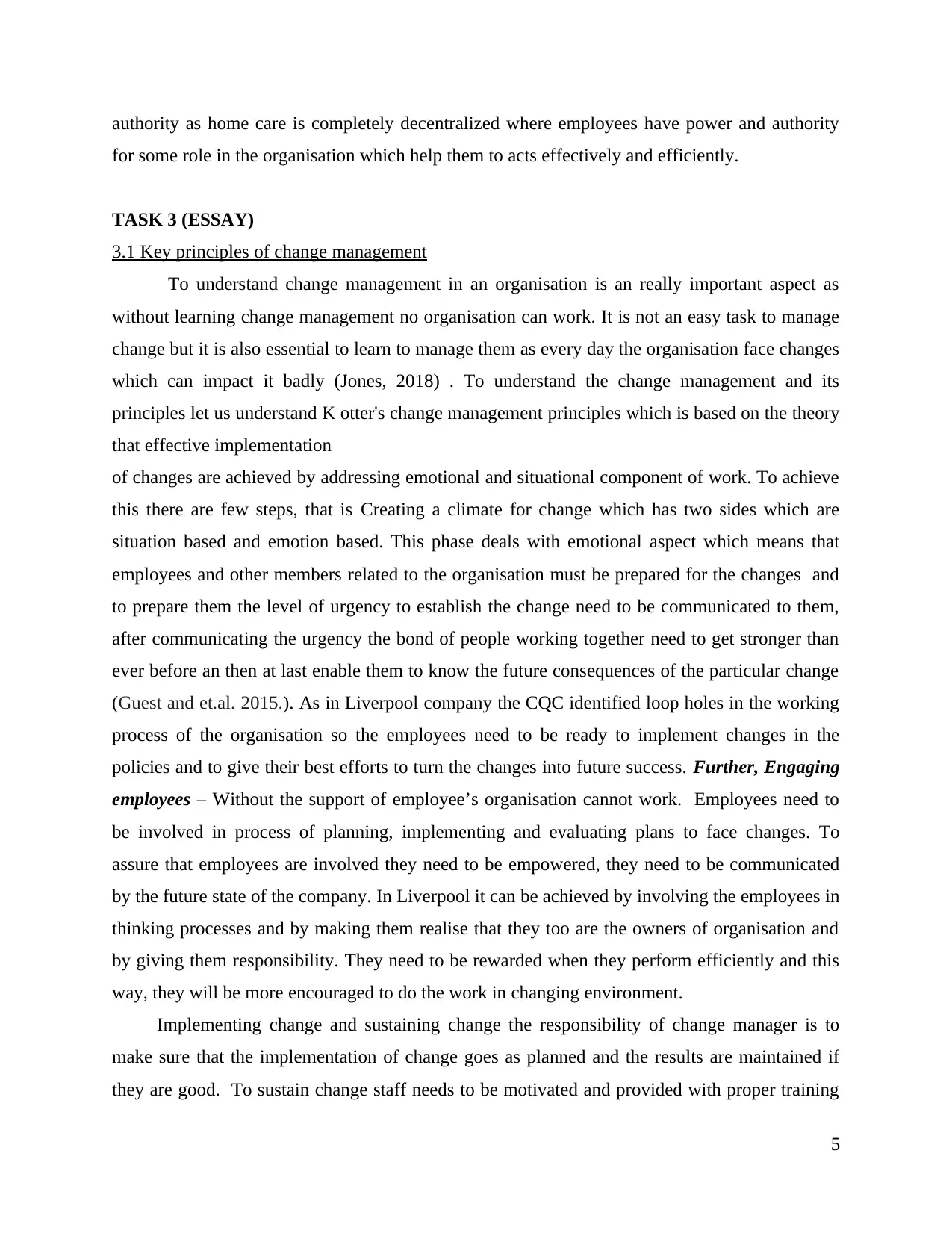
authority as home care is completely decentralized where employees have power and authority
for some role in the organisation which help them to acts effectively and efficiently.
TASK 3 (ESSAY)
3.1 Key principles of change management
To understand change management in an organisation is an really important aspect as
without learning change management no organisation can work. It is not an easy task to manage
change but it is also essential to learn to manage them as every day the organisation face changes
which can impact it badly (Jones, 2018) . To understand the change management and its
principles let us understand K otter's change management principles which is based on the theory
that effective implementation
of changes are achieved by addressing emotional and situational component of work. To achieve
this there are few steps, that is Creating a climate for change which has two sides which are
situation based and emotion based. This phase deals with emotional aspect which means that
employees and other members related to the organisation must be prepared for the changes and
to prepare them the level of urgency to establish the change need to be communicated to them,
after communicating the urgency the bond of people working together need to get stronger than
ever before an then at last enable them to know the future consequences of the particular change
(Guest and et.al. 2015.). As in Liverpool company the CQC identified loop holes in the working
process of the organisation so the employees need to be ready to implement changes in the
policies and to give their best efforts to turn the changes into future success. Further, Engaging
employees – Without the support of employee’s organisation cannot work. Employees need to
be involved in process of planning, implementing and evaluating plans to face changes. To
assure that employees are involved they need to be empowered, they need to be communicated
by the future state of the company. In Liverpool it can be achieved by involving the employees in
thinking processes and by making them realise that they too are the owners of organisation and
by giving them responsibility. They need to be rewarded when they perform efficiently and this
way, they will be more encouraged to do the work in changing environment.
Implementing change and sustaining change the responsibility of change manager is to
make sure that the implementation of change goes as planned and the results are maintained if
they are good. To sustain change staff needs to be motivated and provided with proper training
5
for some role in the organisation which help them to acts effectively and efficiently.
TASK 3 (ESSAY)
3.1 Key principles of change management
To understand change management in an organisation is an really important aspect as
without learning change management no organisation can work. It is not an easy task to manage
change but it is also essential to learn to manage them as every day the organisation face changes
which can impact it badly (Jones, 2018) . To understand the change management and its
principles let us understand K otter's change management principles which is based on the theory
that effective implementation
of changes are achieved by addressing emotional and situational component of work. To achieve
this there are few steps, that is Creating a climate for change which has two sides which are
situation based and emotion based. This phase deals with emotional aspect which means that
employees and other members related to the organisation must be prepared for the changes and
to prepare them the level of urgency to establish the change need to be communicated to them,
after communicating the urgency the bond of people working together need to get stronger than
ever before an then at last enable them to know the future consequences of the particular change
(Guest and et.al. 2015.). As in Liverpool company the CQC identified loop holes in the working
process of the organisation so the employees need to be ready to implement changes in the
policies and to give their best efforts to turn the changes into future success. Further, Engaging
employees – Without the support of employee’s organisation cannot work. Employees need to
be involved in process of planning, implementing and evaluating plans to face changes. To
assure that employees are involved they need to be empowered, they need to be communicated
by the future state of the company. In Liverpool it can be achieved by involving the employees in
thinking processes and by making them realise that they too are the owners of organisation and
by giving them responsibility. They need to be rewarded when they perform efficiently and this
way, they will be more encouraged to do the work in changing environment.
Implementing change and sustaining change the responsibility of change manager is to
make sure that the implementation of change goes as planned and the results are maintained if
they are good. To sustain change staff needs to be motivated and provided with proper training
5
Paraphrase This Document
Need a fresh take? Get an instant paraphrase of this document with our AI Paraphraser
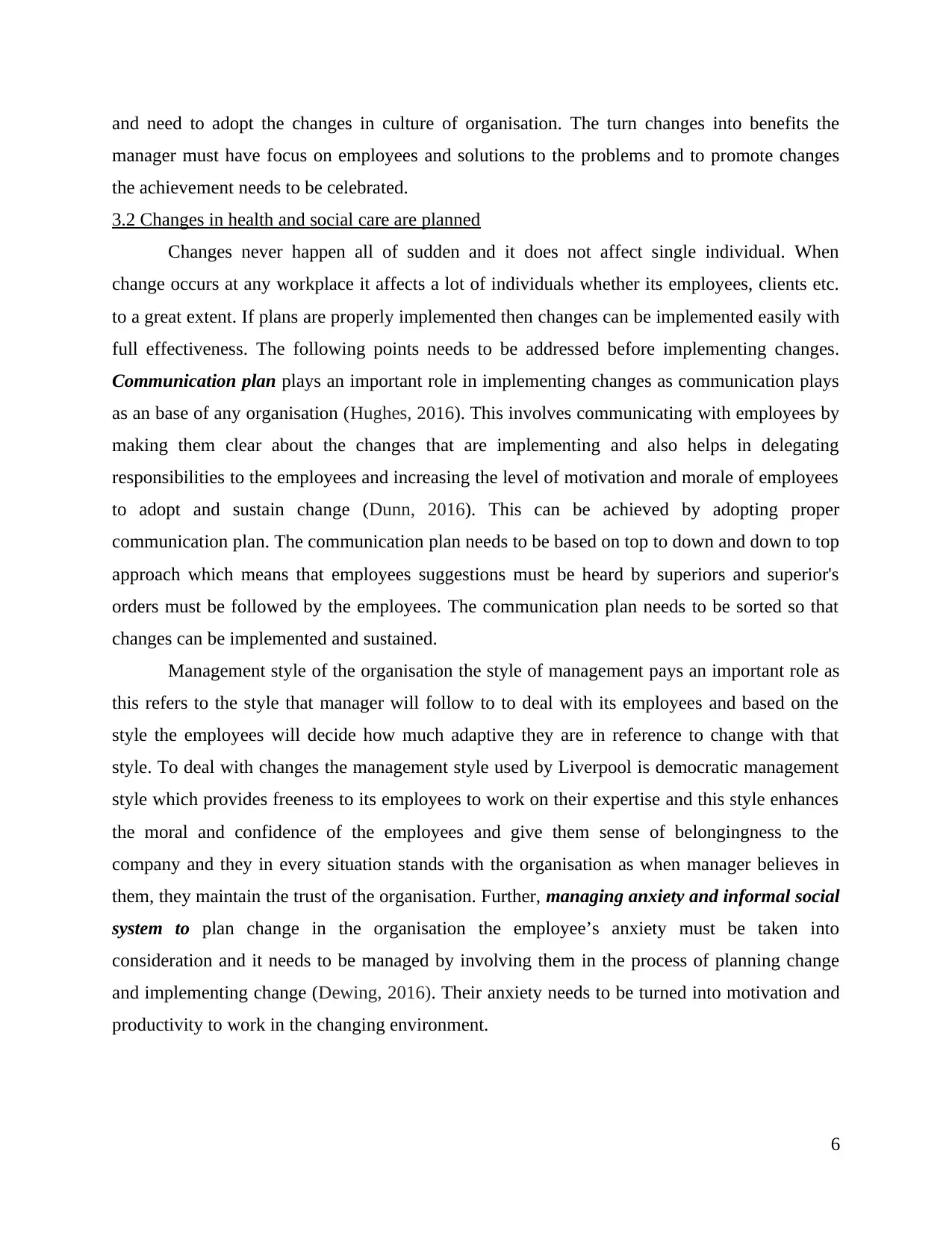
and need to adopt the changes in culture of organisation. The turn changes into benefits the
manager must have focus on employees and solutions to the problems and to promote changes
the achievement needs to be celebrated.
3.2 Changes in health and social care are planned
Changes never happen all of sudden and it does not affect single individual. When
change occurs at any workplace it affects a lot of individuals whether its employees, clients etc.
to a great extent. If plans are properly implemented then changes can be implemented easily with
full effectiveness. The following points needs to be addressed before implementing changes.
Communication plan plays an important role in implementing changes as communication plays
as an base of any organisation (Hughes, 2016). This involves communicating with employees by
making them clear about the changes that are implementing and also helps in delegating
responsibilities to the employees and increasing the level of motivation and morale of employees
to adopt and sustain change (Dunn, 2016). This can be achieved by adopting proper
communication plan. The communication plan needs to be based on top to down and down to top
approach which means that employees suggestions must be heard by superiors and superior's
orders must be followed by the employees. The communication plan needs to be sorted so that
changes can be implemented and sustained.
Management style of the organisation the style of management pays an important role as
this refers to the style that manager will follow to to deal with its employees and based on the
style the employees will decide how much adaptive they are in reference to change with that
style. To deal with changes the management style used by Liverpool is democratic management
style which provides freeness to its employees to work on their expertise and this style enhances
the moral and confidence of the employees and give them sense of belongingness to the
company and they in every situation stands with the organisation as when manager believes in
them, they maintain the trust of the organisation. Further, managing anxiety and informal social
system to plan change in the organisation the employee’s anxiety must be taken into
consideration and it needs to be managed by involving them in the process of planning change
and implementing change (Dewing, 2016). Their anxiety needs to be turned into motivation and
productivity to work in the changing environment.
6
manager must have focus on employees and solutions to the problems and to promote changes
the achievement needs to be celebrated.
3.2 Changes in health and social care are planned
Changes never happen all of sudden and it does not affect single individual. When
change occurs at any workplace it affects a lot of individuals whether its employees, clients etc.
to a great extent. If plans are properly implemented then changes can be implemented easily with
full effectiveness. The following points needs to be addressed before implementing changes.
Communication plan plays an important role in implementing changes as communication plays
as an base of any organisation (Hughes, 2016). This involves communicating with employees by
making them clear about the changes that are implementing and also helps in delegating
responsibilities to the employees and increasing the level of motivation and morale of employees
to adopt and sustain change (Dunn, 2016). This can be achieved by adopting proper
communication plan. The communication plan needs to be based on top to down and down to top
approach which means that employees suggestions must be heard by superiors and superior's
orders must be followed by the employees. The communication plan needs to be sorted so that
changes can be implemented and sustained.
Management style of the organisation the style of management pays an important role as
this refers to the style that manager will follow to to deal with its employees and based on the
style the employees will decide how much adaptive they are in reference to change with that
style. To deal with changes the management style used by Liverpool is democratic management
style which provides freeness to its employees to work on their expertise and this style enhances
the moral and confidence of the employees and give them sense of belongingness to the
company and they in every situation stands with the organisation as when manager believes in
them, they maintain the trust of the organisation. Further, managing anxiety and informal social
system to plan change in the organisation the employee’s anxiety must be taken into
consideration and it needs to be managed by involving them in the process of planning change
and implementing change (Dewing, 2016). Their anxiety needs to be turned into motivation and
productivity to work in the changing environment.
6
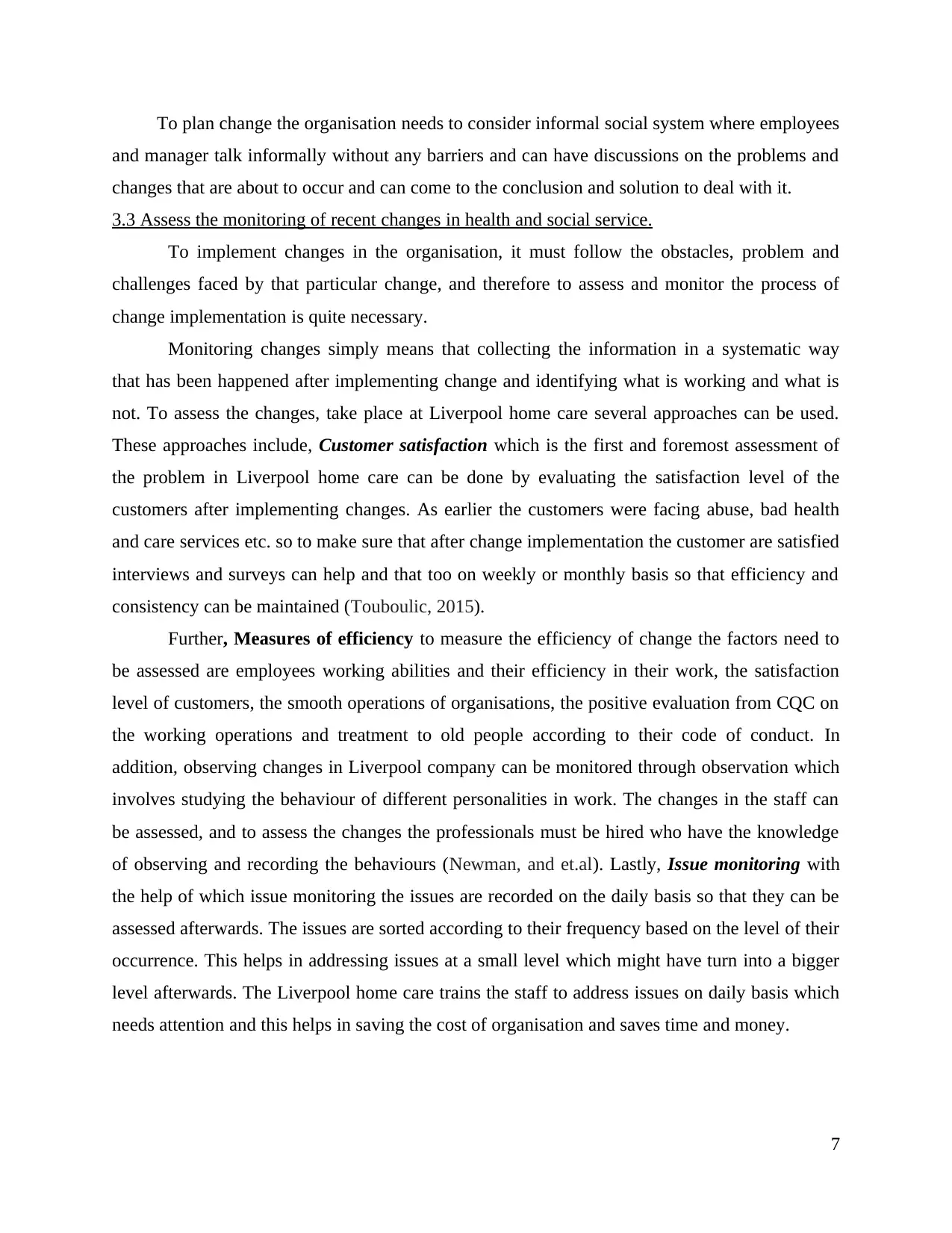
To plan change the organisation needs to consider informal social system where employees
and manager talk informally without any barriers and can have discussions on the problems and
changes that are about to occur and can come to the conclusion and solution to deal with it.
3.3 Assess the monitoring of recent changes in health and social service.
To implement changes in the organisation, it must follow the obstacles, problem and
challenges faced by that particular change, and therefore to assess and monitor the process of
change implementation is quite necessary.
Monitoring changes simply means that collecting the information in a systematic way
that has been happened after implementing change and identifying what is working and what is
not. To assess the changes, take place at Liverpool home care several approaches can be used.
These approaches include, Customer satisfaction which is the first and foremost assessment of
the problem in Liverpool home care can be done by evaluating the satisfaction level of the
customers after implementing changes. As earlier the customers were facing abuse, bad health
and care services etc. so to make sure that after change implementation the customer are satisfied
interviews and surveys can help and that too on weekly or monthly basis so that efficiency and
consistency can be maintained (Touboulic, 2015).
Further, Measures of efficiency to measure the efficiency of change the factors need to
be assessed are employees working abilities and their efficiency in their work, the satisfaction
level of customers, the smooth operations of organisations, the positive evaluation from CQC on
the working operations and treatment to old people according to their code of conduct. In
addition, observing changes in Liverpool company can be monitored through observation which
involves studying the behaviour of different personalities in work. The changes in the staff can
be assessed, and to assess the changes the professionals must be hired who have the knowledge
of observing and recording the behaviours (Newman, and et.al). Lastly, Issue monitoring with
the help of which issue monitoring the issues are recorded on the daily basis so that they can be
assessed afterwards. The issues are sorted according to their frequency based on the level of their
occurrence. This helps in addressing issues at a small level which might have turn into a bigger
level afterwards. The Liverpool home care trains the staff to address issues on daily basis which
needs attention and this helps in saving the cost of organisation and saves time and money.
7
and manager talk informally without any barriers and can have discussions on the problems and
changes that are about to occur and can come to the conclusion and solution to deal with it.
3.3 Assess the monitoring of recent changes in health and social service.
To implement changes in the organisation, it must follow the obstacles, problem and
challenges faced by that particular change, and therefore to assess and monitor the process of
change implementation is quite necessary.
Monitoring changes simply means that collecting the information in a systematic way
that has been happened after implementing change and identifying what is working and what is
not. To assess the changes, take place at Liverpool home care several approaches can be used.
These approaches include, Customer satisfaction which is the first and foremost assessment of
the problem in Liverpool home care can be done by evaluating the satisfaction level of the
customers after implementing changes. As earlier the customers were facing abuse, bad health
and care services etc. so to make sure that after change implementation the customer are satisfied
interviews and surveys can help and that too on weekly or monthly basis so that efficiency and
consistency can be maintained (Touboulic, 2015).
Further, Measures of efficiency to measure the efficiency of change the factors need to
be assessed are employees working abilities and their efficiency in their work, the satisfaction
level of customers, the smooth operations of organisations, the positive evaluation from CQC on
the working operations and treatment to old people according to their code of conduct. In
addition, observing changes in Liverpool company can be monitored through observation which
involves studying the behaviour of different personalities in work. The changes in the staff can
be assessed, and to assess the changes the professionals must be hired who have the knowledge
of observing and recording the behaviours (Newman, and et.al). Lastly, Issue monitoring with
the help of which issue monitoring the issues are recorded on the daily basis so that they can be
assessed afterwards. The issues are sorted according to their frequency based on the level of their
occurrence. This helps in addressing issues at a small level which might have turn into a bigger
level afterwards. The Liverpool home care trains the staff to address issues on daily basis which
needs attention and this helps in saving the cost of organisation and saves time and money.
7
⊘ This is a preview!⊘
Do you want full access?
Subscribe today to unlock all pages.

Trusted by 1+ million students worldwide
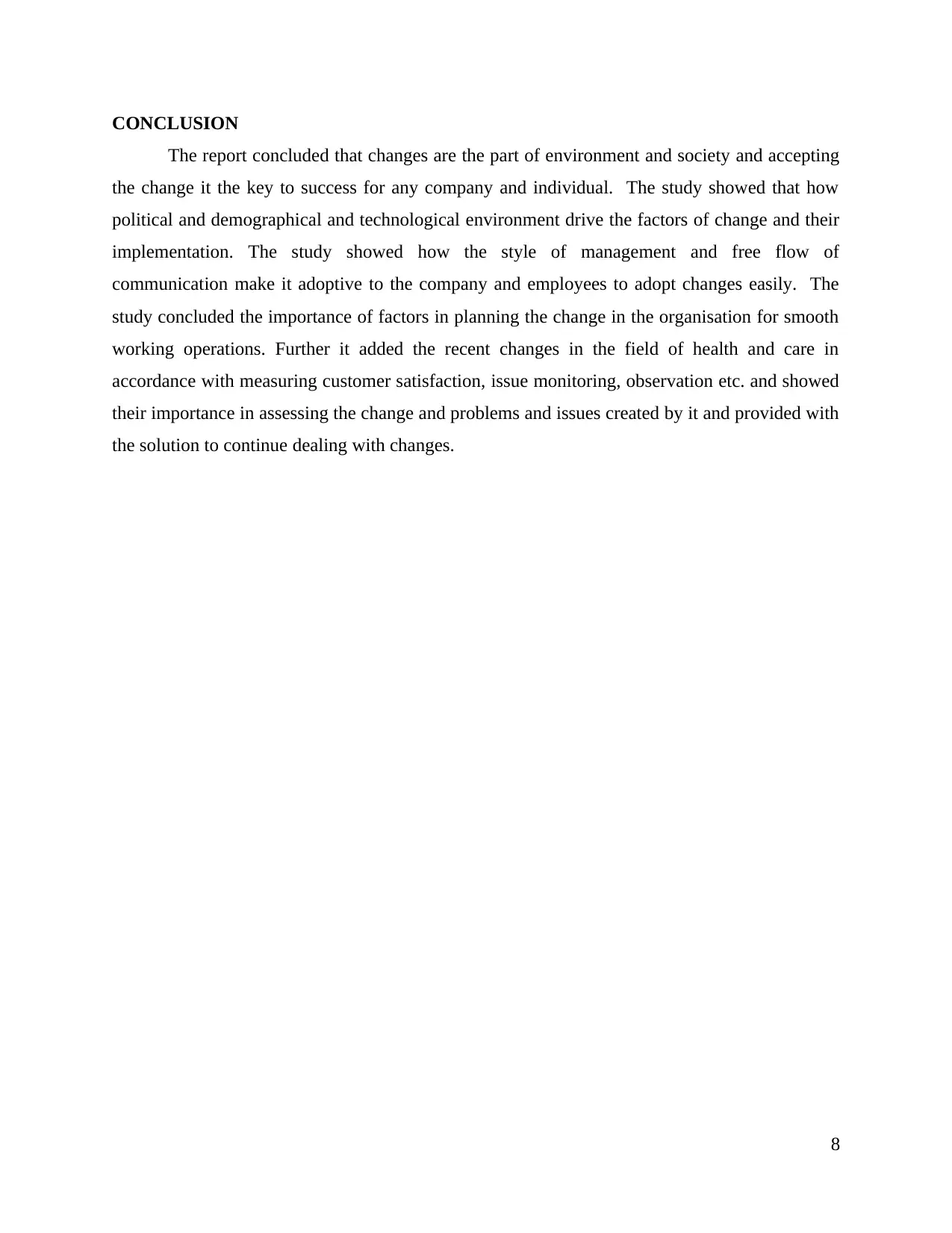
CONCLUSION
The report concluded that changes are the part of environment and society and accepting
the change it the key to success for any company and individual. The study showed that how
political and demographical and technological environment drive the factors of change and their
implementation. The study showed how the style of management and free flow of
communication make it adoptive to the company and employees to adopt changes easily. The
study concluded the importance of factors in planning the change in the organisation for smooth
working operations. Further it added the recent changes in the field of health and care in
accordance with measuring customer satisfaction, issue monitoring, observation etc. and showed
their importance in assessing the change and problems and issues created by it and provided with
the solution to continue dealing with changes.
8
The report concluded that changes are the part of environment and society and accepting
the change it the key to success for any company and individual. The study showed that how
political and demographical and technological environment drive the factors of change and their
implementation. The study showed how the style of management and free flow of
communication make it adoptive to the company and employees to adopt changes easily. The
study concluded the importance of factors in planning the change in the organisation for smooth
working operations. Further it added the recent changes in the field of health and care in
accordance with measuring customer satisfaction, issue monitoring, observation etc. and showed
their importance in assessing the change and problems and issues created by it and provided with
the solution to continue dealing with changes.
8
Paraphrase This Document
Need a fresh take? Get an instant paraphrase of this document with our AI Paraphraser
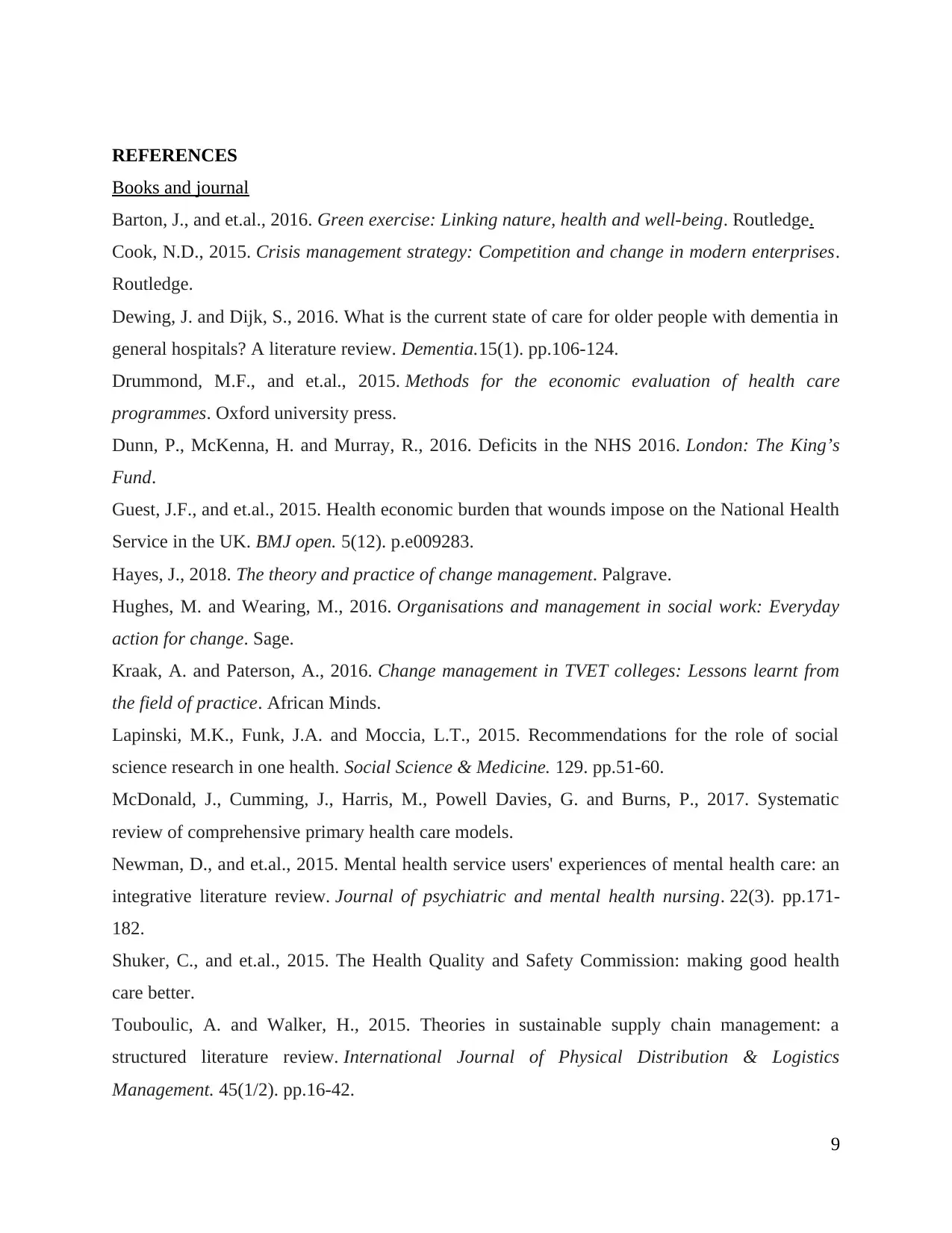
REFERENCES
Books and journal
Barton, J., and et.al., 2016. Green exercise: Linking nature, health and well-being. Routledge.
Cook, N.D., 2015. Crisis management strategy: Competition and change in modern enterprises.
Routledge.
Dewing, J. and Dijk, S., 2016. What is the current state of care for older people with dementia in
general hospitals? A literature review. Dementia.15(1). pp.106-124.
Drummond, M.F., and et.al., 2015. Methods for the economic evaluation of health care
programmes. Oxford university press.
Dunn, P., McKenna, H. and Murray, R., 2016. Deficits in the NHS 2016. London: The King’s
Fund.
Guest, J.F., and et.al., 2015. Health economic burden that wounds impose on the National Health
Service in the UK. BMJ open. 5(12). p.e009283.
Hayes, J., 2018. The theory and practice of change management. Palgrave.
Hughes, M. and Wearing, M., 2016. Organisations and management in social work: Everyday
action for change. Sage.
Kraak, A. and Paterson, A., 2016. Change management in TVET colleges: Lessons learnt from
the field of practice. African Minds.
Lapinski, M.K., Funk, J.A. and Moccia, L.T., 2015. Recommendations for the role of social
science research in one health. Social Science & Medicine. 129. pp.51-60.
McDonald, J., Cumming, J., Harris, M., Powell Davies, G. and Burns, P., 2017. Systematic
review of comprehensive primary health care models.
Newman, D., and et.al., 2015. Mental health service users' experiences of mental health care: an
integrative literature review. Journal of psychiatric and mental health nursing. 22(3). pp.171-
182.
Shuker, C., and et.al., 2015. The Health Quality and Safety Commission: making good health
care better.
Touboulic, A. and Walker, H., 2015. Theories in sustainable supply chain management: a
structured literature review. International Journal of Physical Distribution & Logistics
Management. 45(1/2). pp.16-42.
9
Books and journal
Barton, J., and et.al., 2016. Green exercise: Linking nature, health and well-being. Routledge.
Cook, N.D., 2015. Crisis management strategy: Competition and change in modern enterprises.
Routledge.
Dewing, J. and Dijk, S., 2016. What is the current state of care for older people with dementia in
general hospitals? A literature review. Dementia.15(1). pp.106-124.
Drummond, M.F., and et.al., 2015. Methods for the economic evaluation of health care
programmes. Oxford university press.
Dunn, P., McKenna, H. and Murray, R., 2016. Deficits in the NHS 2016. London: The King’s
Fund.
Guest, J.F., and et.al., 2015. Health economic burden that wounds impose on the National Health
Service in the UK. BMJ open. 5(12). p.e009283.
Hayes, J., 2018. The theory and practice of change management. Palgrave.
Hughes, M. and Wearing, M., 2016. Organisations and management in social work: Everyday
action for change. Sage.
Kraak, A. and Paterson, A., 2016. Change management in TVET colleges: Lessons learnt from
the field of practice. African Minds.
Lapinski, M.K., Funk, J.A. and Moccia, L.T., 2015. Recommendations for the role of social
science research in one health. Social Science & Medicine. 129. pp.51-60.
McDonald, J., Cumming, J., Harris, M., Powell Davies, G. and Burns, P., 2017. Systematic
review of comprehensive primary health care models.
Newman, D., and et.al., 2015. Mental health service users' experiences of mental health care: an
integrative literature review. Journal of psychiatric and mental health nursing. 22(3). pp.171-
182.
Shuker, C., and et.al., 2015. The Health Quality and Safety Commission: making good health
care better.
Touboulic, A. and Walker, H., 2015. Theories in sustainable supply chain management: a
structured literature review. International Journal of Physical Distribution & Logistics
Management. 45(1/2). pp.16-42.
9
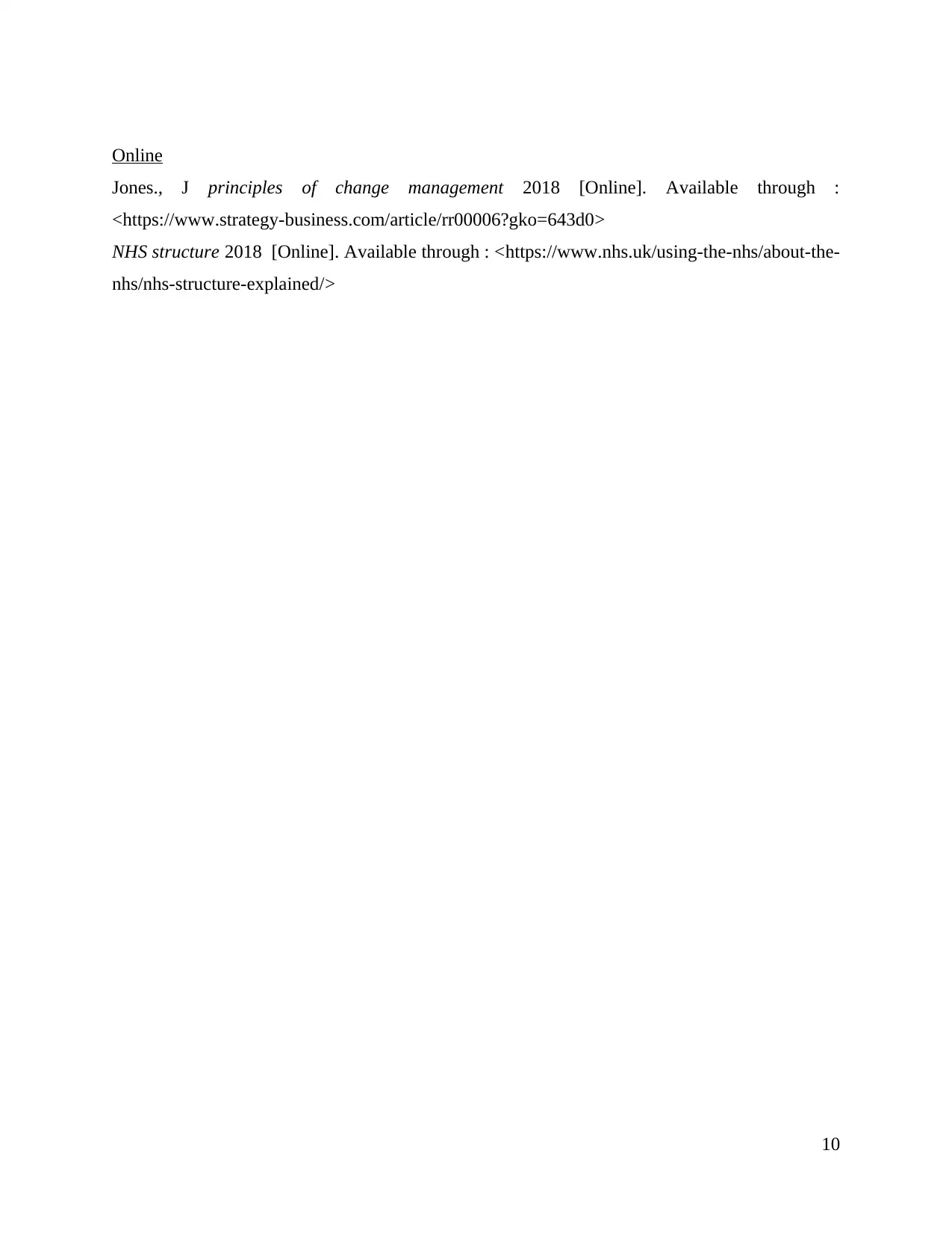
Online
Jones., J principles of change management 2018 [Online]. Available through :
<https://www.strategy-business.com/article/rr00006?gko=643d0>
NHS structure 2018 [Online]. Available through : <https://www.nhs.uk/using-the-nhs/about-the-
nhs/nhs-structure-explained/>
10
Jones., J principles of change management 2018 [Online]. Available through :
<https://www.strategy-business.com/article/rr00006?gko=643d0>
NHS structure 2018 [Online]. Available through : <https://www.nhs.uk/using-the-nhs/about-the-
nhs/nhs-structure-explained/>
10
⊘ This is a preview!⊘
Do you want full access?
Subscribe today to unlock all pages.

Trusted by 1+ million students worldwide
1 out of 12
Related Documents
Your All-in-One AI-Powered Toolkit for Academic Success.
+13062052269
info@desklib.com
Available 24*7 on WhatsApp / Email
![[object Object]](/_next/static/media/star-bottom.7253800d.svg)
Unlock your academic potential
Copyright © 2020–2025 A2Z Services. All Rights Reserved. Developed and managed by ZUCOL.





